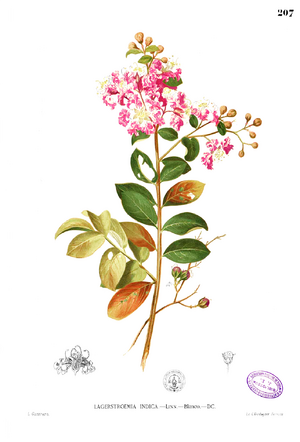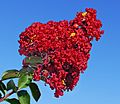Crape myrtle facts for kids
Quick facts for kids Crape myrtle |
|
|---|---|
 |
|
| Lagerstroemia indica | |
| Scientific classification |
|
| Kingdom: | Plantae |
| Clade: | Tracheophytes |
| Clade: | Angiosperms |
| Clade: | Eudicots |
| Clade: | Rosids |
| Order: | Myrtales |
| Family: | Lythraceae |
| Subfamily: | Lythroideae |
| Genus: | Lagerstroemia Linnaeus |
| Species | |
|
See text |
|
The Crape myrtle (also spelled crepe myrtle) is a beautiful flowering plant. It belongs to a group of about 50 different kinds of deciduous (meaning they lose their leaves in fall) and evergreen (meaning they keep their leaves all year) trees and shrubs. These plants originally come from places like the Indian subcontinent, Southeast Asia, and parts of Australia. People grow them all over the world in warmer areas because of their lovely, colorful flowers. Crape myrtles are part of the plant family called Lythraceae. The plant was named after Magnus von Lagerström, a Swedish merchant who helped the famous scientist Carl Linnaeus collect plants.
Contents
About Crape Myrtles
Crape myrtles are most famous for their bright, long-lasting flowers that bloom in summer. Most types of Lagerstroemia have interesting, twisty stems and branches. Their bark often peels off throughout the year, giving them a cool, mottled (spotty) look. Their leaves grow in pairs and have smooth edges, usually measuring from 5 to 20 centimeters (2 to 8 inches) long.
These plants can be very different in size. Some can grow taller than 30 meters (100 feet), while others stay very small, under 30 centimeters (1 foot) tall. Most crape myrtles are small to medium-sized trees or shrubs with several trunks. In places where the weather changes with the seasons, their leaves also turn pretty colors in the fall.
The flowers appear in summer and fall. They grow in clusters and have a crinkled, crêpe-like texture. You can find them in many colors, from deep purple to red to white, and almost every shade in between. There are no true blue, orange, or yellow crape myrtle flowers, though the center parts (stamens and pistils) might be yellow. After the flowers, the plant produces a fruit that looks like a capsule. It starts green and soft, then turns dark brown or black and dry. This capsule splits open to release many small, winged seeds.
In warm climates, both tropical and subtropical crape myrtles are popular in gardens and public spaces. The wood from some types has been used to make things like bridges, furniture, and railway ties. Some insects, like the larvae (caterpillars) of certain moths and butterflies, eat crape myrtle leaves. For example, the Antheraea paphia moth, which produces tassar silk (a type of wild silk), feeds on the leaves of L. parviflora.
Crape myrtles can sometimes get sick. They can be affected by a fungus called powdery mildew, which makes their leaves look dusty. More recently, a pest called bark scale, caused by tiny insects called aphids, has been a problem. These aphids leave behind a black, fungal infection.
Growing Crape Myrtles
People use certain types of crape myrtles in their gardens and yards in many ways. They can be planted to create privacy screens, as single beautiful trees on a lawn, as part of a shrub border, or even in pots. Since crape myrtles grow in many places, there are different ideas on how best to care for them.
Crape myrtles grow best in warmer southern climates, usually in areas known as US zones 7–9. They love lots of sunshine. You can find them in a wide range of flower colors and sizes to fit different garden needs.
Some people used to think crape myrtles were messy plants. However, their seedpods do not stain concrete. This means they are great for planting near swimming pools, decks, and sidewalks without making a mess.
Different Kinds of Crape Myrtles
There are many different species (kinds) of crape myrtles. Here are a few examples:
- Lagerstroemia anhuiensis
- Lagerstroemia anisontera
- Lagerstroemia anisoptera
- Lagerstroemia balansae
- Lagerstroemia calyculata
- Lagerstroemia caudata
- Lagerstroemia cristata
- Lagerstroemia excelsa
- Lagerstroemia fauriei
- Lagerstroemia floribunda
- Lagerstroemia fordii
- Lagerstroemia glabra
- Lagerstroemia guilinensis
- Lagerstroemia indica
- Lagerstroemia intermedia
- Lagerstroemia langkawiensis
- Lagerstroemia limii
- Lagerstroemia loudonii
- Lagerstroemia micrantha
- Lagerstroemia microcarpa
- Lagerstroemia minuticarpa
- Lagerstroemia indica
- Lagerstroemia ovalifolia
- Lagerstroemia paniculata
- Lagerstroemia parviflora
- Lagerstroemia siamica
- Lagerstroemia speciosa
- Lagerstroemia stenopetala
- Lagerstroemia subcostata
- Lagerstroemia subsessilifolia
- Lagerstroemia suprareticulata
- Lagerstroemia tomentosa
- Lagerstroemia turbinata Koehne
- Lagerstroemia venusta
- Lagerstroemia villosa
The most common crape myrtle, L. indica, comes from China and Korea. It was brought to the United States around 1790 by a French botanist named André Michaux. In nature, this plant often grows as a large shrub with many stems. But over 200 years of growing them, people have created many different types (called cultivars) with various features. Today, you can find L. indica varieties for many garden needs. Some are neat street trees, others form thick hedges, and some are fast-growing dwarf types that stay under 60 centimeters (2 feet) tall. These small ones can even bloom in their first year from seed! In Europe, crape myrtle is common in southern France, Spain, Portugal, and most of Italy. In the United States, it's a very popular plant in gardens across the southern states. It's also grown in many parts of Australia, especially where the climate is similar to the Mediterranean.
Another important type is the Japanese crape myrtle, L. fauriei, which comes from central and southern Japan. This species is becoming more popular for landscaping and for creating new hybrid plants by mixing it with L. indica. L. fauriei grows more like a tree, with colorful bark that peels off and dark green leaves. These leaves are also more resistant to plant diseases caused by fungi than its more common relative. The Japanese name for this tree means "monkey slip" because of its smooth, slippery bark. Its flowers are as big as those of L. indica, but they are white, sometimes with a very light pink tint. The Japanese crape myrtle can handle colder weather better than many L. indica types. This makes it valuable for creating new varieties that are stronger and more disease-resistant.
L. speciosa, also known as queen crape myrtle or giant crape myrtle, comes from tropical India. It's a large evergreen tree with beautiful rosy-purple flowers and striking white bark. It's great for public parks and wide streets. Unlike L. indica and L. fauriei, which have many different cultivated types, L. speciosa is usually sold as a seed-grown plant.
Images for kids
See also
 In Spanish: Lagerstroemia para niños
In Spanish: Lagerstroemia para niños









